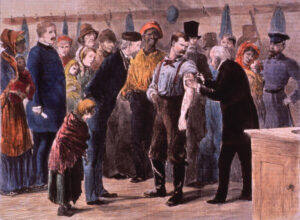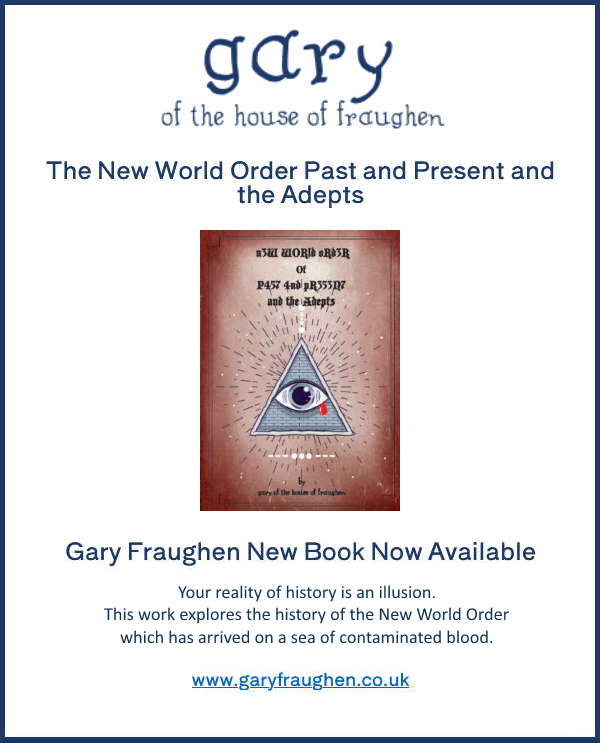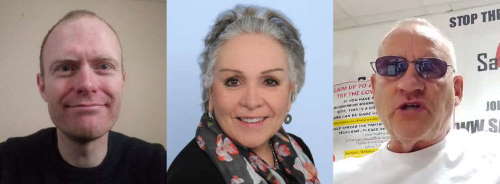Echoes of the smallpox era
Fri 10:33 am +00:00, 10 Sep 2021| This is a very important point that I want you to understand and remember: that 50% of the deaths occurred within 48 hours of getting the shot, while 80% occurred within a week. An informal survey on Twitter, to which 10,000 people responded, also asked whether respondents knew someone who died after a COVID-19 jab. Twelve percent said they did. “When people see others in their circle dying, you can’t stop that type of organic COVID jab hesitancy,” McCullough said. Other confirmed adverse effects of the COVID jabs include myocarditis and blood clots. POST from New York Times below As disease and death reigned around them, some Americans declared that they would never get vaccinated and raged at government efforts to compel them. Anti-vaccination groups spread propaganda about terrible side effects and corrupt doctors. State officials tried to ban mandates, and people made fake vaccination certificates to evade inoculation rules already in place. |
| The years were 1898 to 1903, and the disease was smallpox. News articles and health board reports describe crowds of parents marching to schoolhouses to demand that their unvaccinated children be allowed in, said Michael Willrich, a professor of history at Brandeis University, with some even burning their own arms with nitric acid to mimic the characteristic scar left by the smallpox vaccine.
|
| “People went to some pretty extraordinary lengths not to comply,” said Professor Willrich, who wrote “Pox: An American History,” a book about the civil liberties battles prompted by the epidemic. |
| If it all sounds familiar, well, there is nothing new under the sun: not years that feel like centuries, not the wailing and gnashing of teeth over masks, and not vaccine mandates either. |
| As the coronavirus overwhelms hospitals across the South and more than 650,000 Americans — an increasing number of them children — lie dead, the same pattern is emerging. On Thursday, President Biden announced that he would move to require most federal workers and contractors to be vaccinated and, more sweepingly, that all employers with 100 or more employees would have to mandate vaccines or weekly testing. Colleges, businesses and local governments have enacted mandates at a steady pace, and conservative anger has built accordingly. |
| On Monday, Representative Jim Jordan, Republican of Ohio, tweeted that vaccine mandates were “un-American.” In reality, they are a time-honored American tradition. |
| But to be fair, so is public fury over them. |
| “We’re really seeing a lot of echoes of the smallpox era,” said Elena Conis, an associate professor and historian of medicine at the University of California, Berkeley. “Mandates elicit resistance. They always have.” |
| The roots of U.S. vaccine mandates predate both the U.S. and vaccines. The colonies sought to prevent disease outbreaks by quarantining ships from Europe and sometimes, in the case of smallpox, requiring inoculations: a crude and much riskier predecessor to vaccinations in which doctors rubbed live smallpox virus into broken skin to induce a relatively mild infection that would guard against severe infection later. They were a source of enormous fear and anger. |
| In January 1777, George Washington mandated inoculations for the soldiers under his command in the Continental Army, writing that if smallpox were to break out, “we should have more to dread from it, than from the Sword of the Enemy.” Notably, it was in large part the soldiers’ desires that overcame his resistance to a mandate. |
| “They were the ones calling for it,” said Andrew Wehrman, an associate professor of history at Central Michigan University who studies the politics of medicine in the colonial and revolutionary eras. “There’s no record that I have seen — and I’ve looked — of any soldier turning it down, protesting it.” |
| Buoyed by the success of the mandate, Washington wrote to his brother in June 1777 that he was upset by a Virginia law restricting inoculations. “I would rather move for a Law to compell the Masters of Families to inoculate every Child born within a certain limitted time under severe Penalties,” he wrote. |
| Over the next century, many local governments did exactly that. Professor Wehrman this week tweeted an example of what, in an interview, he said was a “ubiquitous” phenomenon: The health board in Urbana, Ohio, Jordan’s hometown, enacted a requirement in 1867 that in any future epidemic, “the heads of families must see that all the members of their families have been vaccinated.” |
| But by the end of the 1800s, opposition was louder and more widespread. Some states, particularly in the West, introduced laws prohibiting vaccine mandates. Others narrowly passed mandates after intense debate. |
| The reasons for resistance were myriad: Some Americans opposed mandates on the grounds of personal liberty; some because they believed lawmakers were in cahoots with vaccine makers; and some because of safety concerns that were, to be fair, more grounded in reality than the modern equivalent. Vaccines then were not regulated the way they are now, and there were documented cases of doses contaminated with tetanus. |
| The government’s response resembled what, today, are wild conspiracy theories. Contrary to the assertions of some on the far right, the Biden administration has never suggested going door to door to force people to take coronavirus vaccines. But in the 1890s and 1900s, that actually happened: Squads of men would enter people’s homes in the middle of the night, breaking down doors if necessary, to inject people with smallpox vaccines. |
| | ||
| Legally speaking, the Supreme Court resolved the issue of mandatory vaccinations in 1905, ruling 7-2 in Jacobson v. Massachusetts that they were constitutional. |
| The Constitution “does not import an absolute right in each person to be, at all times and in all circumstances, wholly freed from restraint,” Justice John Marshall Harlan, known for defending civil liberties, wrote. “Real liberty for all could not exist under the operation of a principle which recognizes the right of each individual person to use his own, whether in respect of his person or his property, regardless of the injury that may be done to others.” |
| In the court of public opinion, there was no such resolution. |
| The polio vaccine was less controversial, mainly because it wasn’t initially mandated and because it had been funded by a widely respected nonprofit: the National Foundation for Infantile Paralysis, now called the March of Dimes. This reduced opposition based on mistrust of pharmaceutical companies, and most parents willingly got their children vaccinated. The measles vaccine, too, was not particularly controversial because mandates were not initially enforced. |
| “Nobody was enforcing vaccination, and so it simply didn’t elicit that mistrust,” Professor Conis said. In the smallpox era, by contrast, “skeptical people said, ‘Well, why are we doing this? It just benefits the companies making the vaccine and the doctors administering the vaccine, and why should we trust any of them?’” |
| But the fear and anger came roaring back with the introduction of childhood vaccination mandates in the 1970s. By 1980, all 50 states required schoolchildren to be vaccinated against an array of diseases. |
| None of it is new, but one thing distinguishes today’s anti-vaccination protesters from those of the past. The opposition was always political. It wasn’t always partisan. |
| “There are plenty of echoes today: There are liberty claims, there are strong sentiments about parental rights, there are concerns about the science, there are concerns about the profit involved,” Professor Willrich said. “But this party divide in terms of who is most likely to be hesitant or refuse a vaccine mandate is really, I think, something of our own 21st-century moment.”
TODAY
Dr. Peter McCullough has an impressive list of credentials1 — he’s an internist, cardiologist, epidemiologist and a full professor of medicine at Texas A&M College of Medicine in Dallas and is the editor of two medical journals and published hundreds of studies in the literature. He’s also among those brave and courageous persons speaking out about the dangers of COVID-19 jabs, and putting his medical license and future livelihood at risk by so doing. “There’s a hunting that’s going on here that’s very disturbing,” McCullough said in an episode of Perspectives on the Pandemic.2 He was referring to state medical boards hunting down doctors and their and threatening revocation of their licenses based on the spreading of unidentified “misinformation.” “This is absolutely astonishing that this is happening over a fair exchange of ideas,” he said. What is Dr. McCullough sharing that the powers that be don’t want you to hear? It’s about COVID-19 injections and, to sum it up in a sentence, “It’s not working and it’s causing tremendous damage.” COVID Jab Efficacy and Safety Overstated From the StartIn the U.S., Operation Warp Speed is the federal effort that fast-tracked COVID-19 jab candidates to market. Gene transfer technology platforms emerged as the frontrunners, including adenoviral DNA platforms or messenger RNA (mRNA) platforms designed to deliver genetic material to the human body. Once the mRNA is injected, the body then takes up the genetic material and changes in some way. These technologies have been under study for years, in most cases being designed to replace a defective gene, which could potentially be used for cancer treatment, for example. Except historically, “all failed,” McCullough said. In November 2020, however, Pfizer, in a joint venture with Germany-based BioNTech, announced that their mRNA-based injection was “more than 90% effective” in a Phase 3 trial.3 This does not mean that 90% of people who get injected will be protected from COVID-19, though, as it’s based on relative risk reduction (RRR). The absolute risk reduction (ARR) for the jab is less than 1%. “Although the RRR considers only participants who could benefit from the jab, the absolute risk reduction (ARR), which is the difference between attack rates with and without a jab, considers the whole population. ARRs tend to be ignored because they give a much less impressive effect size than RRRs,” researchers wrote in The Lancet Microbe in April 2021.4 Nonetheless, the jabs received emergency use authorization. By giving the emergency authorization, not approval, the jab administration constituted a research trial, with the sponsors being the U.S. Centers for Disease Control and Prevention and the Food and Drug Administration. According to McCullough:5
By March 2021, McCullough Was WorriedInitially, McCullough said, it seemed like the experimental jabs might be safe, and about 70% of his patients had received one by December 2020. But by March 2021, he was uncomfortable with what he was seeing. From December 14, 2020, through March 8, 2021, more than 92 million doses of COVID-19 jabs were administered in the U.S. He cited data from the Vaccine Adverse Event Reporting System (VAERS) database, which showed that during that time, there were 1,637 reports of death in people who had received a COVID-19 jab. The CDC and FDA said none of them was related to the jab but, according to McCullough, by January 22, 2021, 186 deaths had been reported — more than enough to reach the mortality signal of concern to stop the program. “With a program this size, anything over 150 deaths would be an alarm signal,” he said. The U.S. “hit 186 deaths with only 27 million Americans jabbed.” McCullough believes if the proper safety boards had been in place, the COVID-19 jab program would have been shut down in February based on safety and risk of death. Such was the case in 1976, when a fast-tracked injection program against swine flu was halted after an estimated 25 to 32 deaths.6 Yet, despite a much larger death toll, COVID-19 jabs continues. As of August 6, 2021, VAERS COVID-19 data showed 12,791 deaths related to the jabs, according to McCullough, and tens of thousands of hospital and clinic visits.7 In an analysis of COVID-19 vaccine death reports from VAERS, researchers found that 86% of the time, nothing else could have caused the death, and it appears the vaccine was the cause.8 The researchers noted, “The sample contains only people jabbed early in the program, and hence is made up primarily of those who are elderly or with significant health conditions. Despite this, there were only 14% of the cases for which a COVID injection reaction could be ruled out as a contributing factor in their death.”9 Further research shows, McCullough stated, and this is a very important point that I want you to understand and remember: that 50% of the deaths occurred within 48 hours of getting the shot, while 80% occurred within a week. An informal survey on Twitter, to which 10,000 people responded, also asked whether respondents knew someone who died after a COVID-19 jab. Twelve percent said they did. “When people see others in their circle dying, you can’t stop that type of organic COVID jab hesitancy,” McCullough said. Other confirmed adverse effects of the COVID jabs include myocarditis and blood clots.10 An Incredible Violation of Human EthicsYour body recognizes the spike protein in COVID-19 jabs as foreign, so it begins to manufacture antibodies to protect you against COVID-19, or so the theory goes. But there’s a problem. The spike protein itself is dangerous and known to circulate in your body at least for weeks and more likely months11 — perhaps much longer — after the COVID jab. In your cells, the spike protein damages blood vessels and can lead to the development of blood clots.12,13 It can go into your brain, adrenal glands, ovaries, heart, skeletal muscles and nerves, causing inflammation, scarring and damage in organs over time. In his practice, McCullough is seeing an array of neurologic syndromes in people who’ve been injected, with symptoms including blindness, paralysis, difficulty swallowing, headaches, ringing in the ears, myocarditis and more. Other research suggests that the heart, brain, immunologic system and hematologic system may be most at risk from the jabs.14 Children, who are at extremely low risk from COVID-19, receive no benefit from the jab, nor do those who have already had COVID and have immunity, McCullough said, calling the situation “a catastrophe in real time” that’s violating human ethics:15
The Pfizer-BioNTech COVID-19 jab received FDA approval on August 23, 2021, but prior to this, million-dollar raffles, free tuition, bonuses and other bribes like free beer and doughnuts were offered to entice people to get injected. When that didn’t work, mandates increased, including for many health care workers, and hundreds of U.S. colleges16 are also requiring students to get jabbed in order to attend. Vaccinated People Are Getting COVID AnywayMedia reports keep referring to the pandemic as a crisis of the unvaccinated, which is simply inaccurate, since COVID-19 continues to affect and spread among those who have been vaccinated. July 30, 2021, the CDC’s Morbidity and Mortality Weekly Report (MMWR) posted online details of an outbreak of COVID-19 that occurred in Barnstable County, Massachusetts — 74% of the cases occurred in fully vaccinated people.17 So-called “breakthrough infections,” which used to be known as vaccine failures, were reported by the CDC far earlier, though, including in their May 28, 2021, MMWR, which documented 10,262 breakthrough infections reported January 1 to April 23, 2021, across 46 states.18 This, they believed, was “likely a substantial undercount,” but rather than continuing to assess the situation, they stopped monitoring most COVID-9 infections among vaccinated people:19
McCullough also mentions antigenic, or immune, escape. If you put a living organism like bacteria or viruses under pressure, via antibiotics, antibodies or chemotherapeutics, for example, but don’t kill them off completely, you can inadvertently encourage their mutation into more virulent strains. Those that escape your immune system end up surviving and selecting mutations to ensure their further survival. COVID-19 has a high capacity for mutation but, if the virus isn’t under pressure, it won’t necessarily see a need to select mutations to, for instance, become more infectious. But if you put it under pressure, as is occurring during the mass vaccination campaign, this may change. McCullough stated:20
How to Break Through the TranceMcCullough believes many health care providers and the U.S. public are in a vaccination trance. It defies logic and commonsense how public officials and hospital executives can see the vaccines failing to work, can see the rising cases of adverse effects and deaths, and yet increasingly issue vaccine mandates or recommend the vaccine to groups for which it clearly shouldn’t be, like pregnant women. McCullough likens it to a form of psychosis or a group neurosis. The U.S. public, however, has seen so much fear, hospitalization and death during the pandemic that they may have been prepared to accept casualties associated with the vaccines. Still, a sizable number of Americans aren’t being fooled. “We’re at this pressure point, and I think right now, in talking to American people in my circles, they’re ready to take a time out,” McCullough said. If it means taking a sabbatical from work or delaying school for a year, many Americans are willing to do it to avoid getting vaccinated. “The only way to stay healthy right now is to stay away from this vaccine. If you get COVID-19, get to one of these treatment networks and get immunity on the other side.”21 McCullough is a proponent of early treatment of COVID-19 and believes treatment options have been suppressed to allow for mass vaccination:22
McCullough believes that eventually people will break out of the jab trance and realize that the answer isn’t these injections, while the handling of the pandemic, including mass jabs, will become a course in violation of human ethics and the Nuremberg code. With fear, isolation, hospitalizations and deaths still occurring, however, it may take years before the fog is lifted.
|














